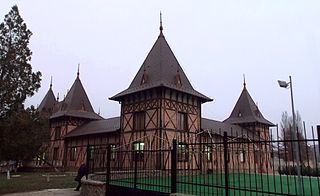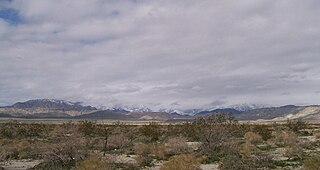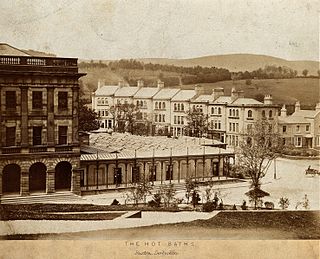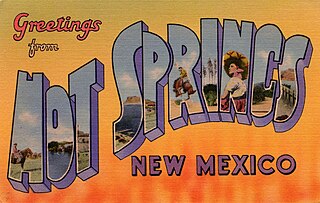
A hot spring, hydrothermal spring, or geothermal spring is a spring produced by the emergence of geothermally heated groundwater onto the surface of the Earth. The groundwater is heated either by shallow bodies of magma or by circulation through faults to hot rock deep in the Earth's crust.

Hot Sulphur Springs is a statutory town and the county seat of Grand County, Colorado, United States. The town is located near Byers Canyon between Granby and Kremmling, 95 miles (153 km) northwest of Denver and 30 miles (48 km) northwest of Winter Park. The town population was 687 at the 2020 census. Its elevation is 7,680 feet (2,340 m).

A spa town is a resort town based on a mineral spa. Patrons visit spas to "take the waters" for their purported health benefits.

Ourense is a city and the capital of the province of Ourense, located in the autonomous community of Galicia, northwestern Spain. It is on the Camino Sanabrés path of the Way of St James, and is crossed by the Miño, Barbaña, Loña and Barbañica rivers. It is also known as A cidade das Burgas due to its hot springs, being one of the European cities with the greatest thermal heritage.

A spring is a natural exit point at which groundwater emerges out of the aquifer and flows onto the top of the Earth's crust (pedosphere) to become surface water. It is a component of the hydrosphere, as well as a part of the water cycle. Springs have long been important for humans as a source of fresh water, especially in arid regions which have relatively little annual rainfall.

Băile Felix is a thermal spa resort near the commune of Sânmartin in Bihor County, Transylvania, Romania. Băile Felix is at a close distance to Oradea, a major city in western Romania.

Mineral springs are naturally occurring springs that produce hard water, water that contains dissolved minerals. Salts, sulfur compounds, and gases are among the substances that can be dissolved in the spring water during its passage underground. In this they are unlike sweet springs, which produce soft water with no noticeable dissolved gasses. The dissolved minerals may alter the water's taste. Mineral water obtained from mineral springs, and the precipitated salts such as Epsom salt have long been important commercial products.

Taiwan is part of the collision zone between the Yangtze Plate and Philippine Sea Plate. Eastern and southern Taiwan are the northern end of the Philippine Mobile Belt.

Poços de Caldas is a municipality in the south of Minas Gerais state, Brazil, in the microregion of the same name. Its estimated population in 2020 was 168,641 inhabitants. The city is known for its hot springs

Pagosa hot springs is a hot spring system located in the San Juan Basin of Archuleta County, Colorado. The town of Pagosa Springs claim they are the world's deepest known geothermal hot springs.

Desert Hot Springs is a geothermal geographic area in Riverside County, California with several hot springs. Since 1941, the California Department of Conservation has recorded approximately 200 geothermal wells that have been drilled in this geographic area; approximately 50 of which are used for commercial spas and pools.
Chunja hot springs is a system of 140 thermal springs located at Uygur District, Almaty Region, Republic of Kazakhstan.

St Ann's Well is an ancient natural warm spring in Buxton, Derbyshire in England. The drinking well is located at the foot of The Slopes and opposite the Crescent hotel and the Old Hall Hotel.

The Buxton Baths using natural thermal spring water are in Buxton, Derbyshire, England. The baths date back to Roman times and were the basis for developing Buxton as a Georgian and Victorian spa town. The present buildings of the Thermal Baths and the Natural Mineral Baths were opened in the 1850s. They are positioned either side of the Buxton Crescent at the foot of The Slopes in the town's Central Conservation Area. They are both Grade II listed buildings designed by Henry Currey, architect for the 7th Duke of Devonshire.

The Aachener Thermalquellen, also known as the Thermal Springs of Aachen and Burtscheid, are a system of more than 30 thermal mineral springs located in the area around Aachen (Aix-la-Chapelle), Germany. The area has been known for its hot sulfur springs for thousands of years.

Truth or Consequences Hot Springs is a thermal spring system located in the Hot Springs Artesian Basin area of Truth or Consequences, New Mexico in Sierra County.

Radium Sulphur Springs, located on the north side of Melrose Avenue between Larchmont and Gower Street in Los Angeles, California, U.S., was an early-20th-century hot spring that resulted from an unsuccessful attempt to drill 1,500 feet (460 m) for oil. "Discovered" in 1905 and opened as a spa by G. P. Gehring in 1908, the owners claimed that the water was radioactive, germicidal, and blood purifying. The supposed radioactivity of water was advertised as "liquid sunshine" and was part of the larger radium fad of the early 20th century. The spa was located in Colegrove, an electric-railway stop and associated community just south of Hollywood.
Beverly Hot Springs is the only remaining natural geothermal hot spring within the center of the city of Los Angeles. It is located between Beverly Hills and downtown Los Angeles on what is now Oxford Avenue.


















